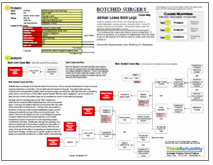In 2011, a kidney donor in Texas bled to death after her renal artery became open. Sadly, her death was associated with the use of clips to close the artery – rather than staples – even though the use of clips was contraindicated for this purpose. The instructions that came with the clips said this, as did several warning letters sent from the manufacturer in previous years.
We can look at this tragic issue in a Cause Map, or visual root cause analysis. We begin with the impacted goals. Because of the patient death, the patient safety goal is impacted. Emotional impacts from employees resulting from a patient death can be considered an effect to the employee impact goal. The use of a device other than intended is a result to the patient services goal and is considered a “never event” (an event which should never happen), resulting in an impact to the compliance goal. A lawsuit resulting from the patient death is an impact to the organization goal. A total of four kidney donors are known to have died as a result of using these clips.
 We begin with the impacted goals and ask “Why” questions to understand the cause-and-effect relationships resulting in this tragedy. The patient died from a massive, sudden bleed caused by the bleeding of the renal artery which was open. The renal artery had been opened as part of the kidney donor surgery, and had been closed using clips that slid off the renal artery. The stump remaining on the renal artery after this kind of surgery is too short to allow the clips adequate purchase, and the clips slid off. The hospital staff was unaware that these clips were contraindicated for this use. Although a warning was placed on the instructions for the clips, these instructions were not kept in the operating room. Additionally, the manufacturer sent out several letters to hospitals warning them not to use these clips for kidney surgery. However, at that time, this hospital was not using the clips, and had forgotten about the letters when the clips were purchased.
We begin with the impacted goals and ask “Why” questions to understand the cause-and-effect relationships resulting in this tragedy. The patient died from a massive, sudden bleed caused by the bleeding of the renal artery which was open. The renal artery had been opened as part of the kidney donor surgery, and had been closed using clips that slid off the renal artery. The stump remaining on the renal artery after this kind of surgery is too short to allow the clips adequate purchase, and the clips slid off. The hospital staff was unaware that these clips were contraindicated for this use. Although a warning was placed on the instructions for the clips, these instructions were not kept in the operating room. Additionally, the manufacturer sent out several letters to hospitals warning them not to use these clips for kidney surgery. However, at that time, this hospital was not using the clips, and had forgotten about the letters when the clips were purchased.
Once the causes related to the issue have been captured, possible solutions can be brainstormed. In this case, there are solutions for all the stakeholders in the event. The operating team should use staples instead of these clips to close the renal artery. The FDA has issued a safety notification to attempt to provide additional warnings against using these clips after kidney donation. The hospital has implemented a system to track and document warnings and recalls related to medical equipment. Some personnel in the medical community have requested that the warning not to use the clips after kidney surgery are printed directly on the clips, rather than on the operating instructions. Dr. Amy Friedman, the Director of Transplant Services at Upstate Medical University in New York, who had raised concerns about using clips in kidney donors starting in 2004, would also like the warnings to include information that donors have died as a result of using these clips. Although the FDA believes that the warnings up to this point have been sufficient, hopefully the additional actions will prevent another death from the use of these clips.
To view the Outline, Cause Map, and Solutions, please click “Download PDF” above. Or click here to read more.









